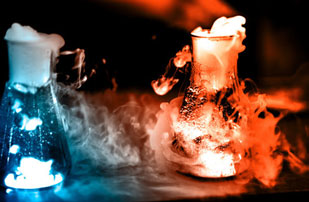Introduction to the Rate of a Chemical Reaction
Determination of the rate of a chemical reaction entails the measurement of the concentration of reactants or products at regular time intervals as the reaction proceeds. When the reaction goes on, the concentrations of reactants decrease as well as those of products boost. The rate of a reaction, as a result, is shown in regard to the rates at which the concentration alters.

The change in concentrations of reactants or products can be figured out by both physical and chemical techniques depending upon the kind of reactants or products involved in the chemical reaction.
- Physical Methods
Several of the techniques made use of for this purpose are the following:
- Spectrometry
This method applies if a reactant or product takes in ultraviolet, visible or infrared radiation. The rate of reaction can be determined by measuring the amount of radiation absorbed.
- Electrical Conductivity Method
The rate of reaction entailing ions can be examined by electrical conductivity method. The conductivity of such a solution depends upon the rate of changes of concentration of the reacting ions or the ions formed during the reaction. The conductivity will be proportional to the rate of changes in the concentration of such ions.
- Dilatometric Approach
This method serves for those reactions, which involve tiny volume changes in solutions. The volume change is directly proportional to the reaction.
- Refractometric Technique
This method is applicable to reactions in solutions, where there are changes in refractive indices of the materials taking part in the chemical reactions.
- Optical Rotation Approach
In this method, the angle whereby plane polarized light is revolved by the reacting mixture is determined by a polarimeter. The level of rotation determines the concentration of an optically energetic compound. If any of the species in the reaction mixture is optically energetic, after that this technique can be followed to find out the rate of reaction.
- Chemical Method
This is especially suitable for reactions in solution. In this method, there is a chemical analysis of a reactant or a product that is involved in a chemical reaction. The acid hydrolysis of an ester (ethyl acetate) in the existence of a small amount of acid is one of the best examples.
CH3COOC2H5 (l) +H2O (l) à CH3COOH (l) + C2H5OH (l)
In the case of hydrolysis of an ester, the solution of ester in water and the acid functioning as a catalyst are enabled to react. After a time, a sample reaction mixture is taken out by a pipette and run into 4 times its volume of ice-cold water. The dilution as well as cooling stops the reaction. The acid formed is titrated against a common alkali, let’s say NaOH, making use of phenolphthalein as an indicator.
The analysis is repeated at numerous time intervals after the beginning of the reaction. This would certainly offer a detail regarding the changes in concentration of acetic acid created during the reaction at different time intervals.
The incline of the curve at any kind of factor will offer the rate of reaction. At first, the rate of reaction is high however it reduces with the flow of time. When the curve ends up being horizontal, the rate of reaction ends up being zero.

If we outline the chart for decreasing concentrations of CH3COOC2H5, after that, dropping curves are acquired. If we have any kind of lab method to record the changing concentration of ester or alcohol, we can measure the rate of reaction.
This is a pseudo-first-order reaction. Actually, water being in large excess in comparison to ester does not affect the rate and we assume that water is not taking part in the reaction.
FAQs: Determination of the Rate of a Chemical Reaction
1. What is the rate of a chemical reaction?
- The rate of a chemical reaction refers to how quickly reactants are consumed or products are formed over time during the course of a reaction.
2. How is the rate of a chemical reaction determined?
- The rate of a chemical reaction is determined by measuring the concentration of reactants or products at regular time intervals as the reaction progresses.
3. What methods are used to determine the rate of a chemical reaction?
- Physical and chemical methods are employed to determine the rate of a chemical reaction. Physical methods include spectrometry, electrical conductivity, dilatometric approach, refractometric technique, and optical rotation approach. Chemical methods involve chemical analysis of reactants or products involved in the reaction.
4. How does spectrometry help determine the rate of reaction?
- Spectrometry measures the amount of ultraviolet, visible, or infrared radiation absorbed by a reactant or product, allowing for determination of the rate of reaction based on the change in radiation absorption over time.
5. What is the principle behind the electrical conductivity method for determining reaction rates?
- The electrical conductivity method measures the rate of changes in concentration of reacting ions or ions formed during the reaction. The conductivity of the solution is proportional to these changes in ion concentration.
6. How is the rate of reaction determined using chemical methods?
- Chemical methods involve analyzing the concentration of reactants or products through chemical reactions. For example, the acid hydrolysis of an ester can be analyzed by titration to determine the rate of formation of products.
7. What is a pseudo-first-order reaction?
- A pseudo-first-order reaction occurs when one reactant is present in excess and its concentration remains nearly constant throughout the reaction. In such cases, the reaction rate appears to depend only on the concentration of the limiting reactant, resulting in a simplified rate expression.

